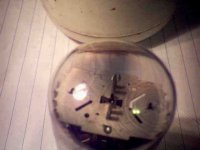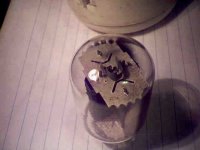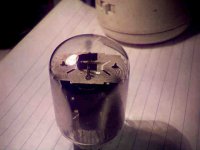I'm new to tubes/valves and don't have a "feel" for this question. I only remember our old RCA BW TV back in the 50's. Seems it had an insatiable appetite for tubes, at least the repairman was out at our house quit regularly. I have a few restorations under my belt now. My latest one is a 1962 AMI stereo jukebox amplifier. It sounds so good, I promoted it to HiFi service in my living room. Between TV and music, I estimate this amp will be running 14 hours a day. The tube complement is 5U4, 12AU7s and P-P 6973s in the outputs. How often will I be replacing tubes in this amp? The Russians are still making the 6973, but for how long? I'd like to stock up on spares while these tubes are still available, but how many will I need?
Bobby Dipole
Bobby Dipole
The AMI Jukebox amp should be pretty easy on tubes.
Tube longevity depends on how hard the tubes are pushed. Many of the 50's TV sets pushed the tubes pretty close to their limits.... shortening their lives.
The Jukebox, on the other hand, was designed to run for extended periods of time without repair.
You should get several years of service befor you'll need to replace the output tubes.
The 12AU7's should last much longer.
Tube longevity depends on how hard the tubes are pushed. Many of the 50's TV sets pushed the tubes pretty close to their limits.... shortening their lives.
The Jukebox, on the other hand, was designed to run for extended periods of time without repair.
You should get several years of service befor you'll need to replace the output tubes.
The 12AU7's should last much longer.
Tubes used to be rated in X 1000s of hours of operation (within ratings). I have no idea how long the re-issue Russian tubes are rated. But the operating environment makes a big difference too. I noticed in the 6973 vs 6CZ5 thread that the original schematic already listed the operating g2 (screen) voltage above the 6973's absolute max g2 V rating. Many of these old tube amps were designed for 110VAC line voltage, but with todays frequent 120 to 125 VAC line voltage, that screen voltage may be way over max tube spec. (I calculate 403 V on g2 for 125 VAC line V, versus the 330 V absolute g2 max spec.! extrapolated from 355 V g2 on the schematic for an assumed 110VAC line) I would recommend (carefully) measuring the operating screen voltage on the 6973 tubes before investing in a stock of pricey 6973 tubes. Alterations may be in order.
Last edited:
The TV's insatiable appetite was likely for horizontal sweep tubes, notorious for their short lifetimes and low quality. In fact many tube retailers historically (and present-day!) offer reduced warranty or no warranty at all on sweep tubes.
There's no reason 6973s shouldn't last a good many years (10? 20?) and small-signal tubes like 12AU7, etc. should last perhaps 50 years. I've got an H.H. Scott 209B amp with original small-signal tubes, all made in 1963 and they're all doing just fine!
Make sure that your tubes are operated within their ratings (as smoking-amp cautions - this is a genuine concern!) and that they're well-ventilated -especially the power tubes.
Electro-Harmonix makes new 6973s, purported to be very good quality- I've been tempted to put together an amp out of them and compare them against 6BQ5s (EL84) -I'd think they should outperform the 6BQ5 in terms of both power output and lower distortion. Should be an interesting comparison of beam power tubes Vs. conventional grids - the 6BQ5 and the 6973 have kinda-sorta similar ratings, otherwise.
Good luck with your jukebox conversion- sounds like a fun project and I'll bet it sounds great!
There's no reason 6973s shouldn't last a good many years (10? 20?) and small-signal tubes like 12AU7, etc. should last perhaps 50 years. I've got an H.H. Scott 209B amp with original small-signal tubes, all made in 1963 and they're all doing just fine!
Make sure that your tubes are operated within their ratings (as smoking-amp cautions - this is a genuine concern!) and that they're well-ventilated -especially the power tubes.
Electro-Harmonix makes new 6973s, purported to be very good quality- I've been tempted to put together an amp out of them and compare them against 6BQ5s (EL84) -I'd think they should outperform the 6BQ5 in terms of both power output and lower distortion. Should be an interesting comparison of beam power tubes Vs. conventional grids - the 6BQ5 and the 6973 have kinda-sorta similar ratings, otherwise.
Good luck with your jukebox conversion- sounds like a fun project and I'll bet it sounds great!
Back when I was a TV repairman, we mostly replaced horizontal sweep tubes (especially on sets with series filaments as in no power transformer! We went through a lot of 38HE7s), some vertical deflection tubes and the occasional color oscillator tube (the ubiquitous 6GH8), so I concur with kruesi.
"I only remember our old RCA BW TV back in the 50's. Seems it had an insatiable appetite for tubes, at least the repairman was out at our house quit regularly"
it's important to understand that most service men carried a borchure that showed different TV screen pictures and based on the picture, a list of suggested tubes where indicated as swap out canidates.
in many cases, good tubes, with lots of hours on them were part of the swap in and ritual. I remember many serviceman putting the old tubes in the original box and putting that box back in his caddy.
These tubes are being discovered across the country on the shelf of closed down TV and radio repair shops.
We call these tubes "NOS"
it's important to understand that most service men carried a borchure that showed different TV screen pictures and based on the picture, a list of suggested tubes where indicated as swap out canidates.
in many cases, good tubes, with lots of hours on them were part of the swap in and ritual. I remember many serviceman putting the old tubes in the original box and putting that box back in his caddy.
These tubes are being discovered across the country on the shelf of closed down TV and radio repair shops.
We call these tubes "NOS"
From purchasing a lot of "sale" TV tubes over the years, the WOOS ones have a discoloration/darkeneing on the top of the bulb directly above the filament, if you can see it (getter flash often in the way). I've had pretty good luck with sale tubes though, usually not more than 10% are WOOS. Some places test the tubes, or at least claim to. Some of the obviously WOOS ones do seem to work OK. The second and 3rd picture is of a less abused one, with just a narrow spot, the shape of the filament/cathode end.
Attachments
Last edited:
- Status
- This old topic is closed. If you want to reopen this topic, contact a moderator using the "Report Post" button.
- Home
- Amplifiers
- Tubes / Valves
- Tube Longevity


